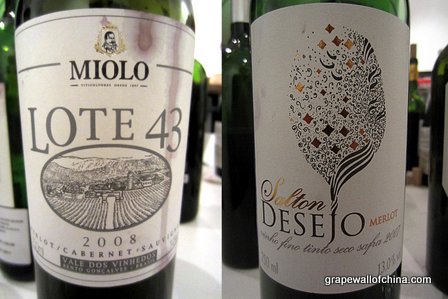By Jim Boyce
Late to taste, last to leave. That sums up a recent Wines of Brasil event I attended in Beijing. I found out about it the day before, could only get to the hotel after 11 AM and, because the tasting finished at noon, ended up hogging a table to the side and powering through the last ten bottles while the distributors packed up.
Even so, I managed to taste ~30 bottles, which increased my Brazilian wine tasting experience by ~1000 percent. While I found a few wines were unbalanced and smelled slightly sweaty and/or sourish, most were fine, ranging from innocuous and easy to drink to pretty good. I even ended up taking five half-full bottles to The Loop for a later tasting.
Before I get to the wines, two notes.
One, the only restaurant I know that stocks Brazilian wines in Beijing is Alameda in Sanlitun, which has several options from Miolo.
Two, China was the top importer of Brazilian wine in the first half of 2012. To be fair, those imports only totaled CNY2.6 million / USD405,00, which is what a prolific bidder might spend in an afternoon at a Hong Kong wine auction, but it is a start. And the organizers of the tasting no doubt hope the upcoming World Cup and Summer Olympics in Brazil will help drive sales. You can get the press release on China’s Brazil wine imports here.
As for the wines…
- Casa Valduga Duetto 2012 is an interesting blend of Syrah and Pinot Noir. Mild, pleasant and easy to drink. I liked it.
- Salton Desejo Merlot 2009: Mild berries, with licorice-mint, oak and spicy smells. Also pleasant and round, with a decent amount of fruit.
- Salton Virtude Chardonnay 2011: Butter and toast smells along with fresh fruit, including green apples. The body was fresh and fairly fruity, with some mineral at the finish.
- Miolo Cuvee Giuseppe Cabernet-Merlot 2009: Dark berries, and something savory, for smells, although even after ten hours — the time between the morning tasting and the one at The Loop — this wine still didn’t seem fully open. The body had steady dark fruit and nice tannins but, again, it seemed tight and not yet open.
- Miolo Cabernet-Merlot Lote 43 2008: My favorite in terms of mouth feel: nice, round and slightly savory, with a lip-smacking finish.
- Miolo Merlot Terroir 2009: This one included dark berry and cola attributes, a somewhat “chewy” body and slightly spicy finish.
- Miolo Cuvee Giuseppe Chardonnay 2011: Peaches, vanilla and a slight nutty smell. Nice and playful fruit but not much body.
There was also a nice Miolo wine called Quinta do Seival made primarily from Touriga Nacional. This one had a wider range of smells — from flowers (violets) to dark earth to berry jam — and a light, soft body. In any case, here is hoping we not only see further Brazil wine tastings in Beijing but also more places stocking a few bottles.
Sign up for the Grape Wall newsletter here. Follow Grape Wall on LinkedIn, Instagram, Facebook and Twitter. And see my sibling sites World Marselan Day, World Baijiu Day and Beijing Boyce. Grape Wall has no advertisers, so if you find the content useful, please help cover the costs via PayPal, WeChat or Alipay. Contact Grape Wall via grapewallofchina (at) gmail.com.

Hi there,
We at Lidio Carraro Winery are very excited about those events over here in Brazil, as we are the producer of FACES – OFFICIAL LICENSED WINE OF 2014 FIFA WORLD CUPâ„¢.
I hope chineses have the chance to taste it too!
Cheers,
Marcia Amaral
lidiointernational@lidiocarraro.com